Sick of knocking at govt office doors, villagers unite and build a bridge

18-July-2015
Vol 6 | Issue 29
A bridge that has been constructed on the river Ghaggar in Haryana is one of a kind. It is a ‘bridge of democracy’.
Because, in the face of continuing governmental apathy, this is a bridge truly ‘for the people, of the people, and totally by the people,’ not just an enduring link between two pieces of land, but a bond uniting thousands of villagers in a common cause.
You could pick up the thread of this remarkable story on 12 November 2014 - just another ordinary day in Panihari village, located on the banks of the Ghaggar river in Sirsa District of Haryana.
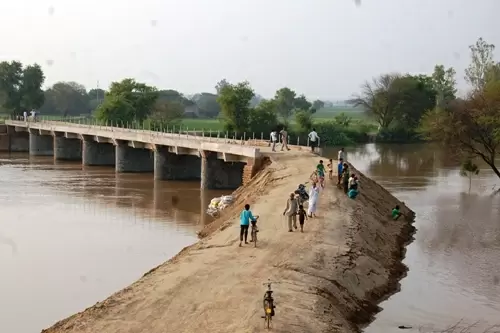 |
|
The bridge will serve the needs of people from more than 30 villages
|
21-year-old Sunny was negotiating the incomplete bridge, wheeling his bicycle with his nephew seated on it, when he lost his balance and fell into the river.
He somehow managed to save himself by swimming ashore, but four-year-old Manish had to be fished out – dead. The day turned dark, and life was never the same in the village.
Just as tragic as the accident was the fact that it wasn’t really one, that it was an incident that could have been averted. The crossing of the river had over time become fraught with negligence.
Gurcharan Singh, a freelance journalist with a Hindi daily, discloses that many accidental deaths were recorded here since 1981.
From what he recalls, in that year in the summer, a tractor going across the river bed, which was full of muck, turned turtle, killing those on board - a 12 year-old girl, a two-year-old baby girl and a woman of a family.
Then in 2005, 55-year-old, Jakar Singh was trailing his cattle to cross over the river, which seemed to be at a low in the twilight. But the old man had failed to guess the depth and drowned.
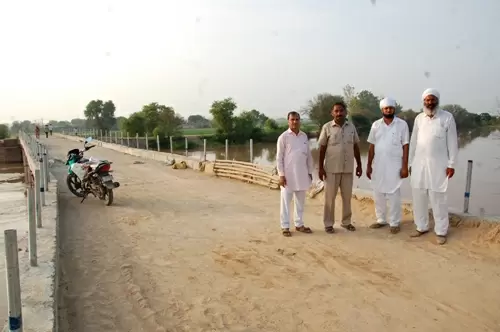 |
|
The bridge was constructed with contributions from the locals, who are now proud of their accomplishment
|
Again in 2007, a 13-year-old boy, Jaswinder Singh, was following his family while crossing over the river. He lost his balance and quickly went underwater.
Human life came cheaply here, and death came repeatedly. And no one in the authorities seemed to care.
The river Ghaggar rises in the Shivaliks of Himachal Pradesh and flows down through Punjab and Haryana into Rajasthan. It swells with rainwater during the monsoons; otherwise, it remains covered with industrial effluents.
The residents of the many villages segueing on either side of the Ghaggar had never found it easy to cross the river. The schoolchildren especially, have much trouble.
A boat service was operated by the State government, but the boatman worked at will, if at all, and only up to 5 pm. Villagers dwelling across the river would have to travel around 40 km to reach Sirsa town, a distance of actually only 14 km from Panihari.
Fed up with their daily struggle to get across the river, in 2010 the villagers laid down a temporary construction of wooden planks, a precarious arrangement at best.
As per the records, the villagers had reached out to government offices since 1995 with applications for the construction of a bridge across the river.
They submitted petitions to every department including the divisional office of Ghaggar Jal Seva, but their requests remained ‘pending’. Even desperately running to the chief minister of Haryana was futile – all they got was a false assurance and no results.
Finally, the villagers of Panihari turned to what was sometimes their first and sometimes only resort – faith.
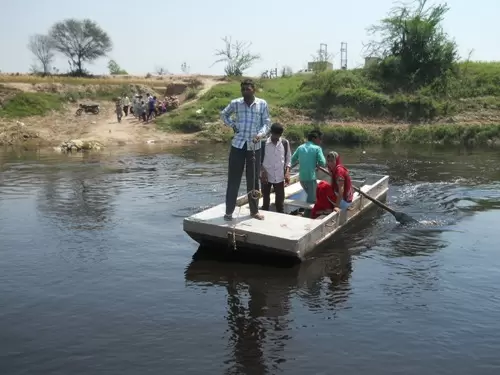 |
|
For many years the villagers were dependent on an erratic boat service operated by the state government
|
They sought help from Mahant Brahma Das, the 12th Saint of Dera Baba Bhuman Shah, who has his ashram 10-12 km away from the village.
The 41-year-old ‘Baba’ Brahma Das had his own history of extraordinary spiritual recoveries at the ashram from near-death when he was a child. The villagers, on the edge of desperation, were looking for a solution. He was their last resort.
If they were expecting a miracle, they got it. But it was one both sought and wrought by men.
Baba Brahma Das declared that the construction of bridge was possible, but only if the villagers came together, without a thought for caste, religion and politics.
Following this, an Akhand Paath (Sikh religious recitation) was organized and was followed by langar (community lunch in the Sikh religion) to enhance the spirit of camaraderie, brotherhood and the sharing of a common goal.
After that the Baba handed over a ‘godly bag’ to the villagers, appealing to them to contribute generously so that they wouldn’t have to depend on the mercy of the government.
The ‘godly bag’, which already had a lakh rupees in it donated by the Baba, was supposedly guaranteed to never run short of funds. Whether this was true or not, the Baba’s blessings and the magical promise of the bag generated a ray of hope among the villagers, who decided to donate for the common cause.
A 25-member committee, with representatives of 11 villages, was formed as the ‘Panihari Pul Committee’. 58-year-old Hardev Singh, a respected landowner in this Panihari village, was made the president of this committee.
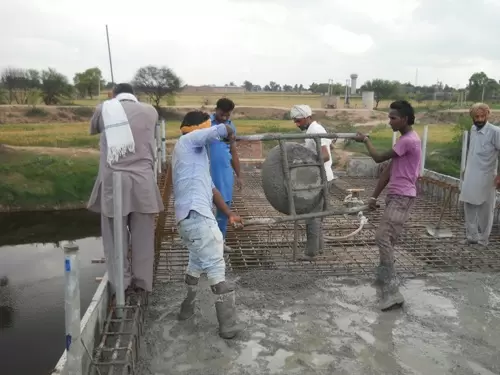 |
|
Villagers not only gave their money but also their labour for building the bridge
|
People from 14-15 villages living close to the Ghaggar started offering whatever funds were within their capacity.
Donations began with rupees ten and shot upwards: Hardev Singh himself contributed Rs 70,000; Charanjeet Singh Rori, Member of Parliament from Sirsa constituency, donated a lakh; Uday Singh Thakur, a guru of the Namdhari Panth from Ludhiana, gave Rs 1.4 lakh; Trilochan Singh, a social activist and a businessman from Alikan village, donated Rs 1.21 lakh; others followed with more or less, depending on what they could give.
And so it came to pass that Baba Brahma Das laid the foundation stone on his birthday, which was also Baisakhi festival day, on 14 April 2014.
Three civil engineers were called in to estimate costs for the project. The bridge was going to be 16 ft wide, 225 ft long and 27 ft height. They calculated a cost of Rs 1.5 crore for the erection of the bridge.
“Till date, a sum of Rs 90 lakh has been collected and spent,” says Hardev Singh, “but we require an additional sum of Rs 10-15 lakh for the rest of the construction work.”
That’s why the bridge was still underway when the river swallowed the little boy and left the villagers broken-hearted.
Which has all left you wondering why on earth would a religious man lead the building of a bridge, a very civilian structure?
“The Panihari villagers gathered and sought my blessing for the cause,” says Sant Brahma Das who equates religion with community service. “Lord Ram too built a bridge. . . It was on the villagers’ request that I laid the foundation stone. I am happy to say that the will of the villagers has led this bridge to completion.”
Notably, the construction of the bridge was in the hands of masons from Rajasthan, who are known to have built a bridge at Nijja Dera village, about 15 km away from Panihari.
Not to be left behind in the construction either, many villagers not only volunteered as labourers but also offering free soil for filling up.
The bridge will connect Panihari village and Alikan on the other side, and serve a catchment of 35 more villages.
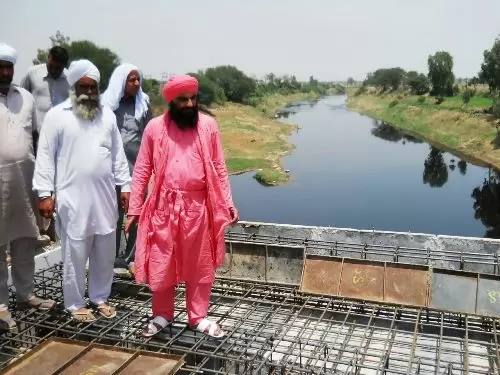 |
|
Sant Brahma Das inspecting the construction of the bridge
|
Saving both distance and time, it will enhance the economy of the area as many villagers have their agricultural field across the river, and others work in Sirsa town. Besides, school-going children will no longer miss their classes.
“You can see the students pedalling down on the new bridge to attend their classes,” says a pleased Manjinder Singh, Panihari village head. “In view of the fact that the bridge is built with the support of people, we will name it ‘Janata Ka Pul’ (People's Bridge).”
Sirsa MP Charanjeet Singh Rori has promised to complete the 2-km stretch across the bridge and the approach roads to it with the funds allotted by the government for developmental work in his constituency.
Whether this promise is fulfilled or not is yet to be seen, but what is proven is the power of common men. And their faith. Together they may or may not move mountains, but they can certainly build a bridge that stands as an example to all.
















